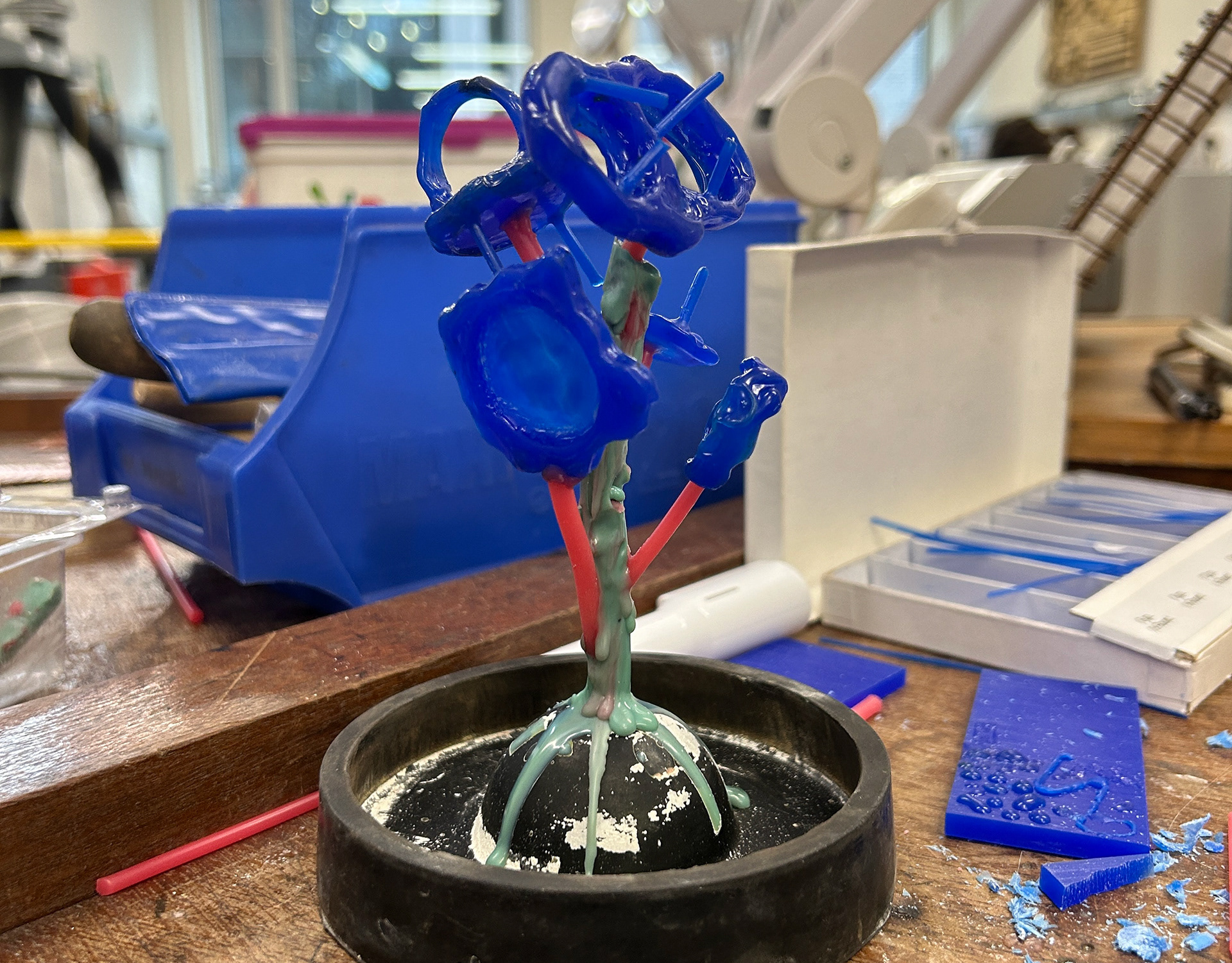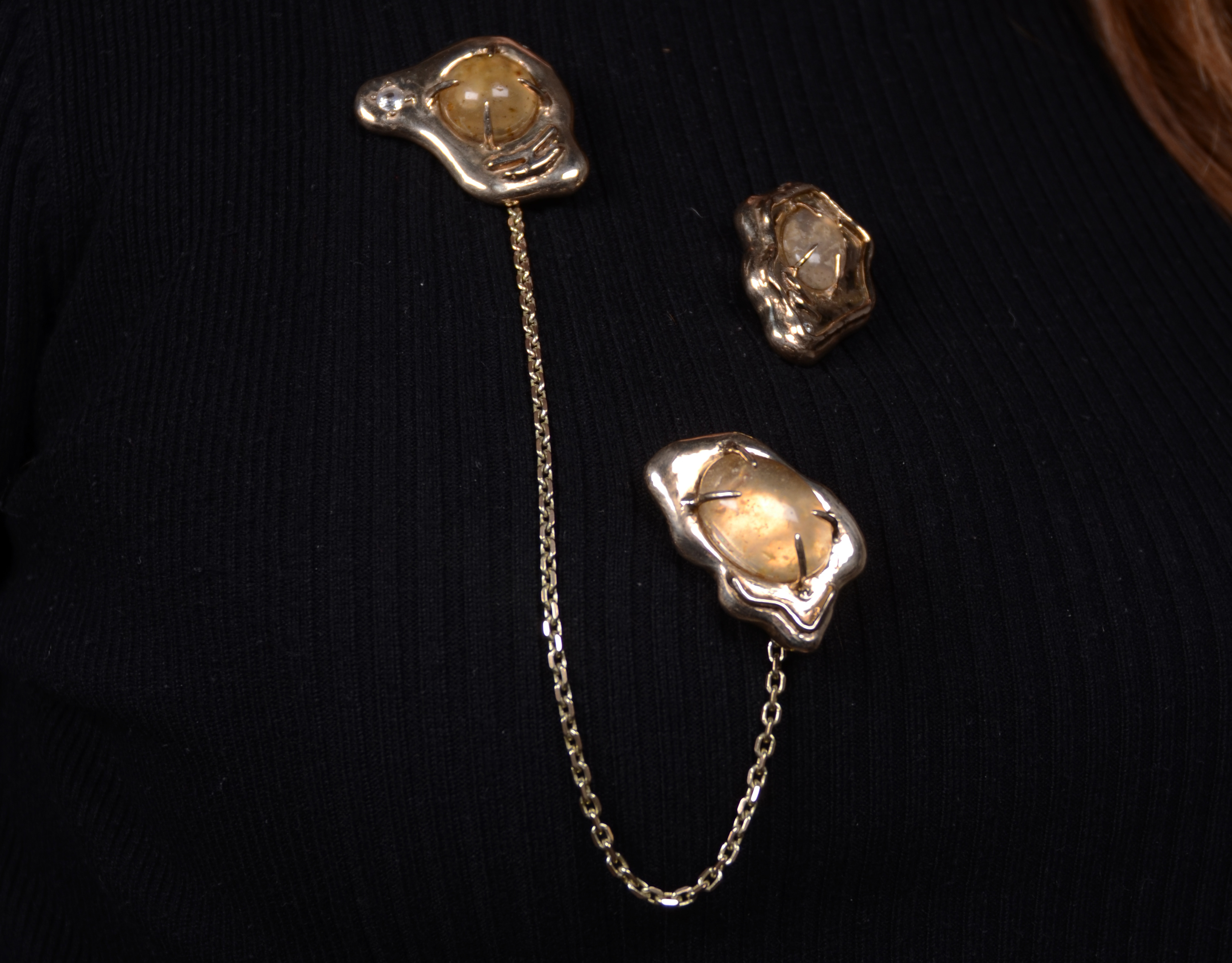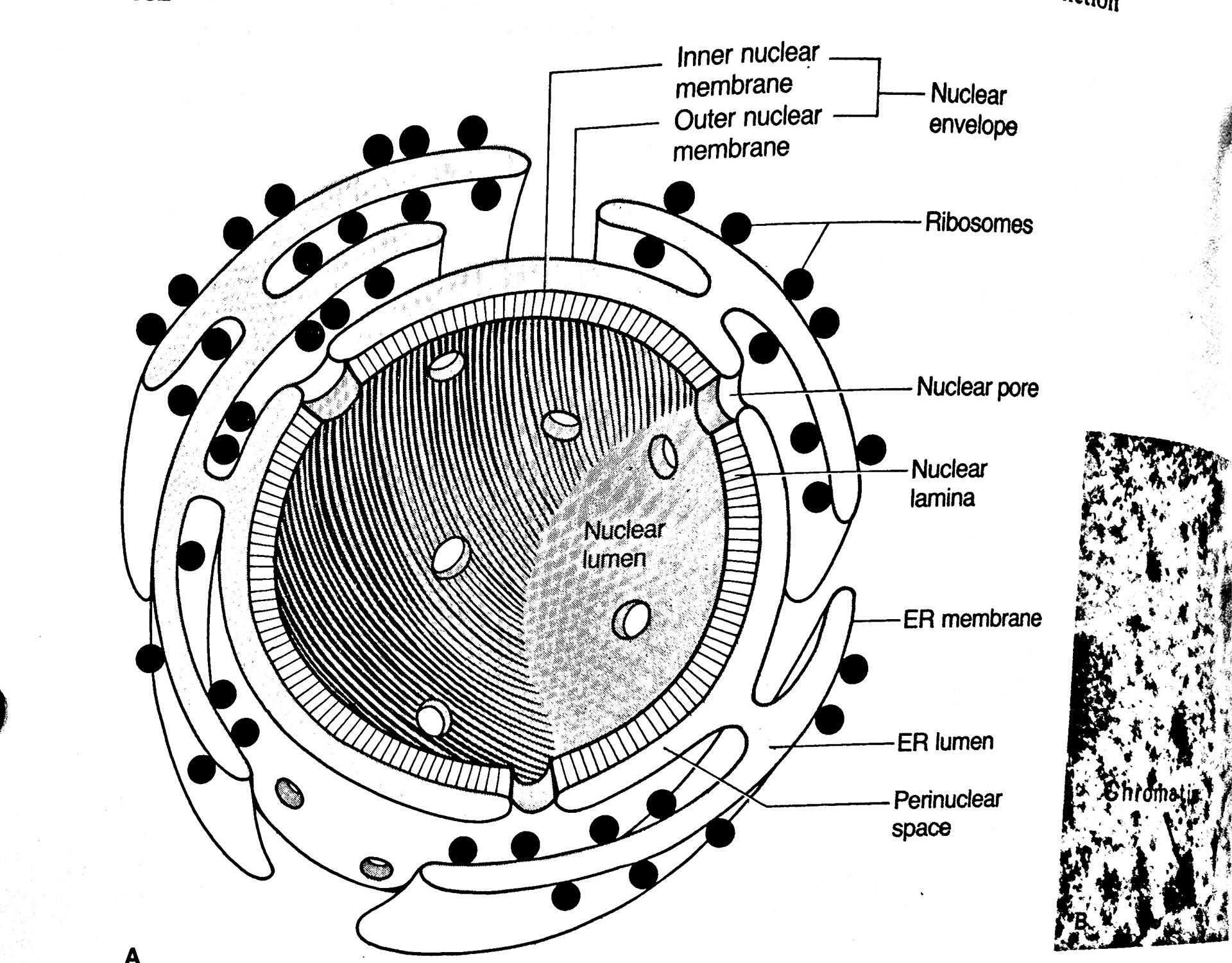History of Engraving
For the project ‘Tradition and Innovation’, I was challenged to look at the ‘Red list’. This collection of crafts is a list of endangered crafts in the UK, put together by Heritage Crafts. The list is categorised into three different threat levels: extinct, critically endangered and, endangered. I was challenged to pick one of these crafts to develop and innovate throughout my project. On this list was hand engraving, while I was surprised to see such a delicate and historic craft on this list, I perused with it, nonetheless. Hand engraving had recently been moved from viable to endangered in 2023, which made me more captivated by the ‘dying’ craft. This also motivated me to use a 'rare' technique in my work.
The history of hand engraving dates to the 1st millennium BC with metal jewellery. These used only simple tools to create relief patterns into the metals, which later developed into the engraving of semi-precious stones, which increased in popularity throughout the ancient world. From here engraving developed in Ancient Egypt almost 15,000 years ago. This was typically used in stone at a much larger scale than jewellery, with pieces being almost 6 feet wide. These engravings were most commonly in the form of hieroglyphics as well as depicting gods and rulers. This changed throughout the Roman Empire, with the most popular type of engraving being used for coins. The engravings would be created in bronze, which was then used to cast silver and gold coins. By the 14th century, these hand-engraved designs were embellishing swords and other weaponry. What I noticed, was that these designs were more decorative embellishments rather than the gods and rulers used in the Egyptian designs. However, I did see some examples of religious connotations on some of the swords, often seen as a sort of protection for battle. These religious associations would often be in the form of Latin words, for example, ‘In Nomine Domini’ meaning in the name of the Lord. Throughout the 16th century and onwards, hand engraving on guns became more popular, with the delicacy of the engraving having a direct impact on the price point. Looking more into gun engraving, I saw many intricate, delicate, and traditional designs. These would often include repeating patterns and motifs all over the piece.

Ancient Egyptian engraving, in the form of hieroglyphics
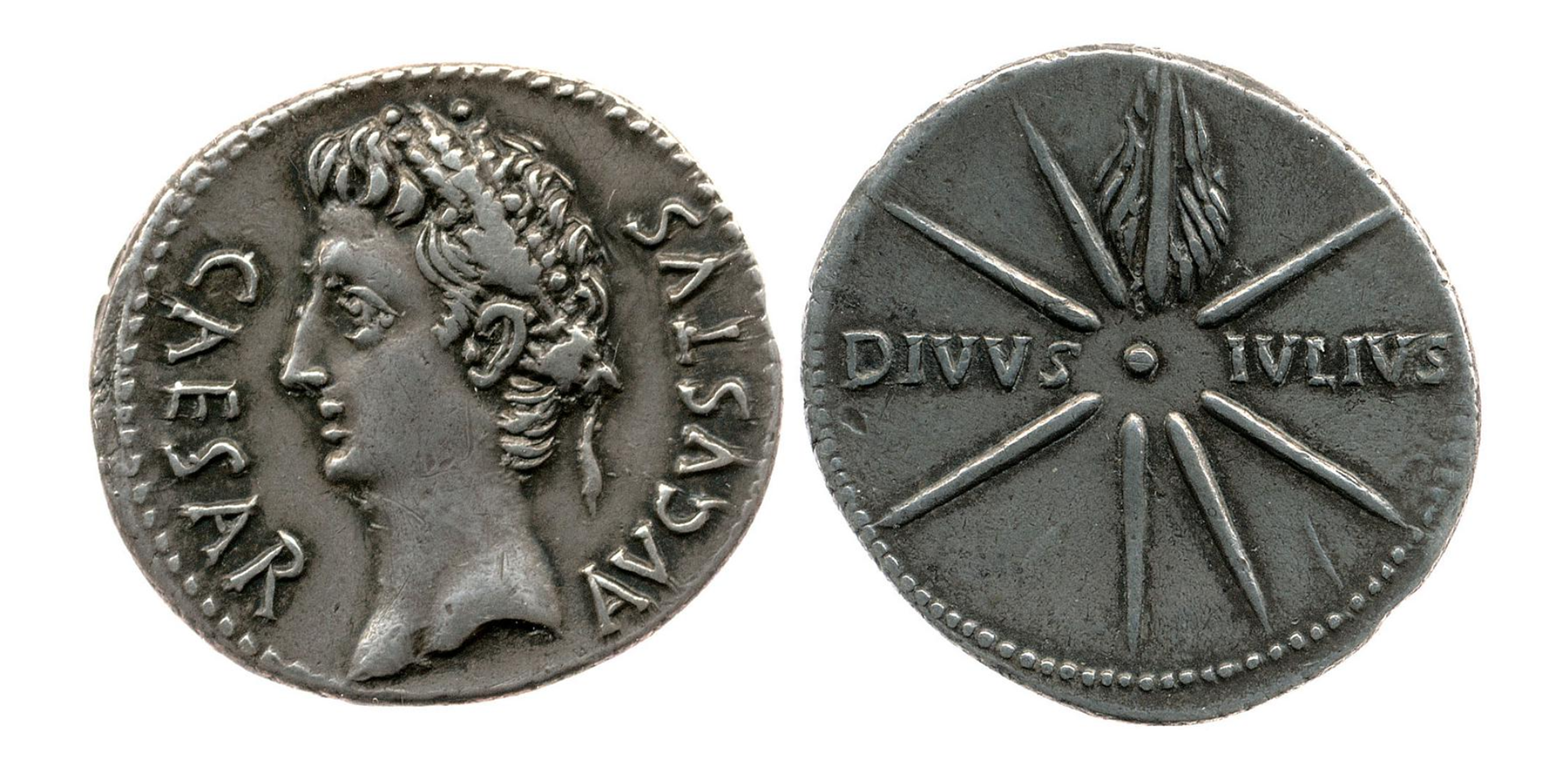
Roman coins cast in silver
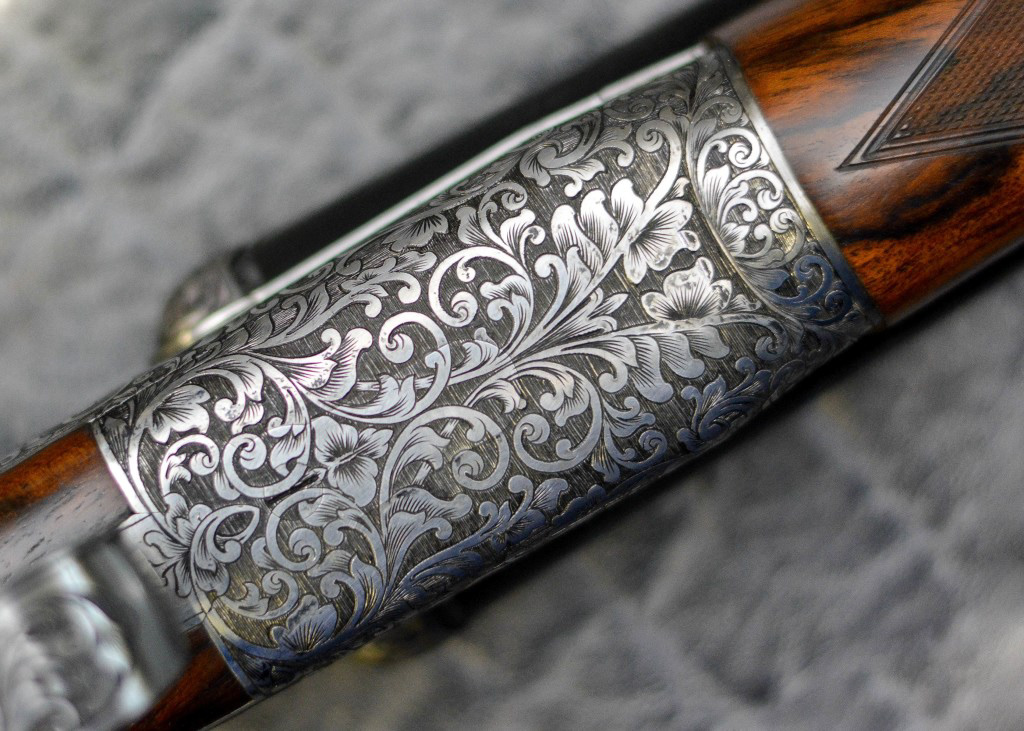
Gun engraving
These three examples are all widely different from each other even though they all use the same technique. For instance, the Ancient Egyptian hieroglyphics depict stories and pictures. As well as that, these are on a significantly larger scale compared to other examples, with the sandstone blocks being almost 7ft tall. This example is carved in sandstone and appears to show King Seti I with the gods Horus and Sobek. Horus was one of the most significant Ancient Egyptian Gods, who represented many purposes, most notably as the ‘god of kingship, healing, protection, the sun and the sky’. This links to the gun engraving, as a sign of protection and power. However, on the sandstone, it is with graphics and drawings, rather than the Latin words used on the guns. On the contrary, the coins show me a statement about power and honour, with Caesar wearing a laurel wreath, a symbol of ‘honour and victory’. On the flip side of the coins lies the phrase “DIVVS IVLIV” meaning ‘Divine Julius’. The history of this design is believed to have stemmed from a comet that appeared over Rome in 44 BC, which was believed to be a sign from Julius himself. Augustus, the new ruler at the time, used this as a sign to emphasize his association with Julius and honour him. This tribute has made me think about memory and honour in my work, which is a concept I hope to explore throughout this project.
Unlike many other jewellery and embellishment techniques, hand engraving itself does not use many materials, only a scraper, spit stick, scorper and graver. Scorpers and gravers can also come in a variety of sizes depending on what profile cut you want, and what the tool is being used for. For instance, a graver is more commonly used for stone setting as it has a larger profile and can lift more metal to securely hold the stone in place. I found it remarkable how something so complex and intricate would only use a handful of tools.
As well as that, I was intrigued by the delicacy and complexity of hand engraving, and while looking at the patterns, specifically on gun engraving, it reminded me of lace. For example, bobbin lace. I decided that this would be a suitable starting point for creating engraved designs so researched traditional hand-woven lace. This was, and still is more popular in Italy, France, Belgium, and Finland, which relates to my heritage. I decided to look more into Finnish lace making as I thought that having something related to my heritage would help me submerse myself into this project. From here I settled on creating more modern jewellery with traditional looks and techniques, which then developed into the idea of creating modular jewellery. The idea of being able to switch and change up jewellery is becoming more popular in a world where unnecessary waste and adaptability of products are more conscious factors for many buyers.
Another part about hand engraving that I want to experiment with, is its ability to be used with different techniques. For example, enamel. This technique is called ‘Basse-taille’. The engraved piece is covered with a translucent enamel, that when fired leaves behind a monotone print which is encased in the enamel. Introducing colour to my work is something I would like to experiment with more and so this seemed like a perfect way to do it. As well as that, engraving can also be used to embellish stone settings, which is also something I want to enhance within my practice.
Summary of hand engraving
- Historic and rich history, which is surprising for a 'dying' craft
- Uses delicate and complex designs
- Can easily be combined with other materials, for example, stone setting and enamelling
Sources:
- https://deakinandfrancis.com/hand-engraving/
- https://engraversmanchester.co.uk/the-art-of-engraving/
- https://www.britannica.com/topic/Horus
- https://egymonuments.gov.eg/monuments/kom-ombo-temple/
- https://www.britishmuseum.org/collection/object/C_1860-0330-22
Traditional Finnish Lace
From my research, I decided to research traditional Finnish bobbin lace. These examples were created by my late Grandmother, who was Finnish
Artist Research
Nick Noyes - Engraving Artist
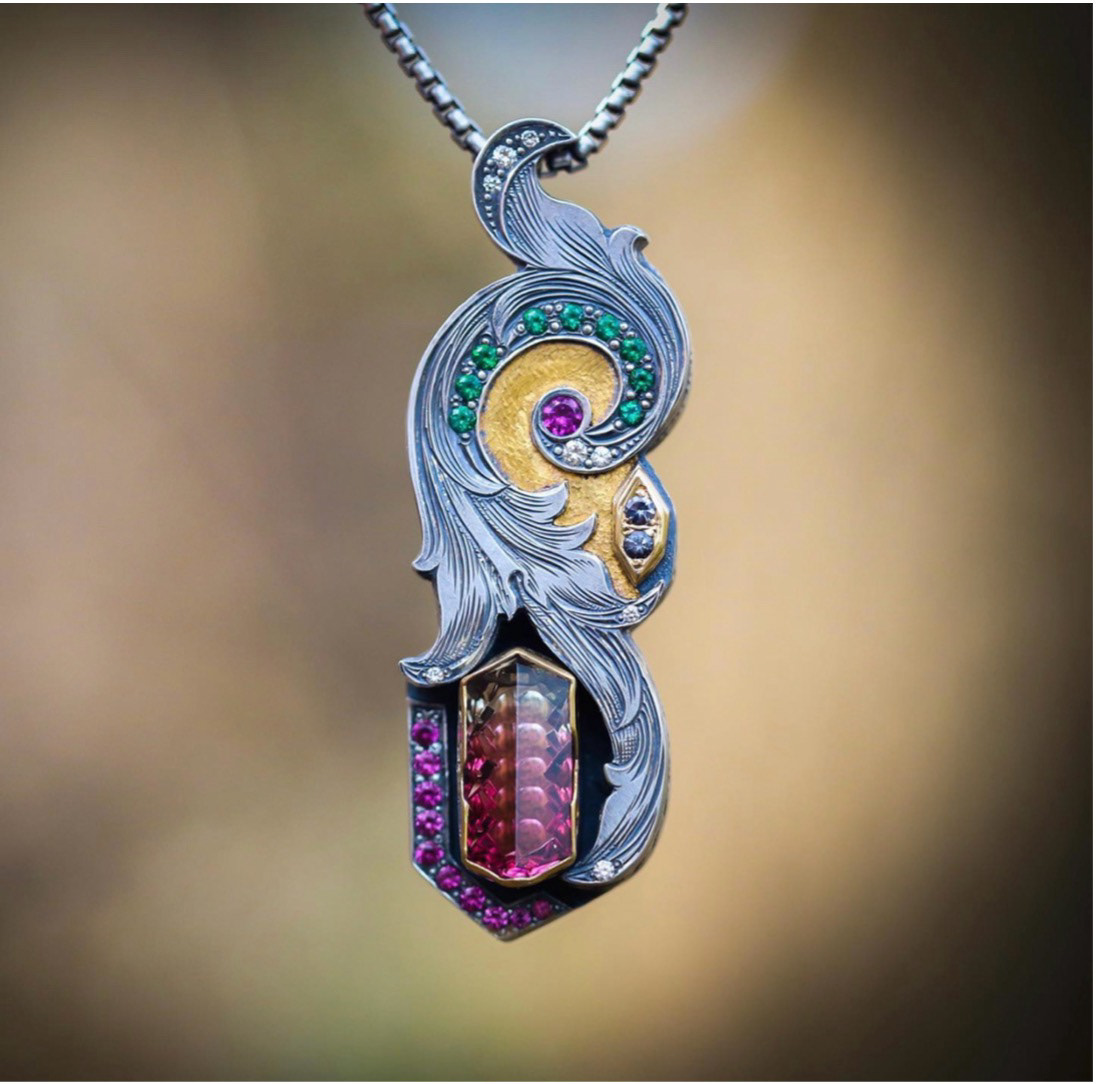
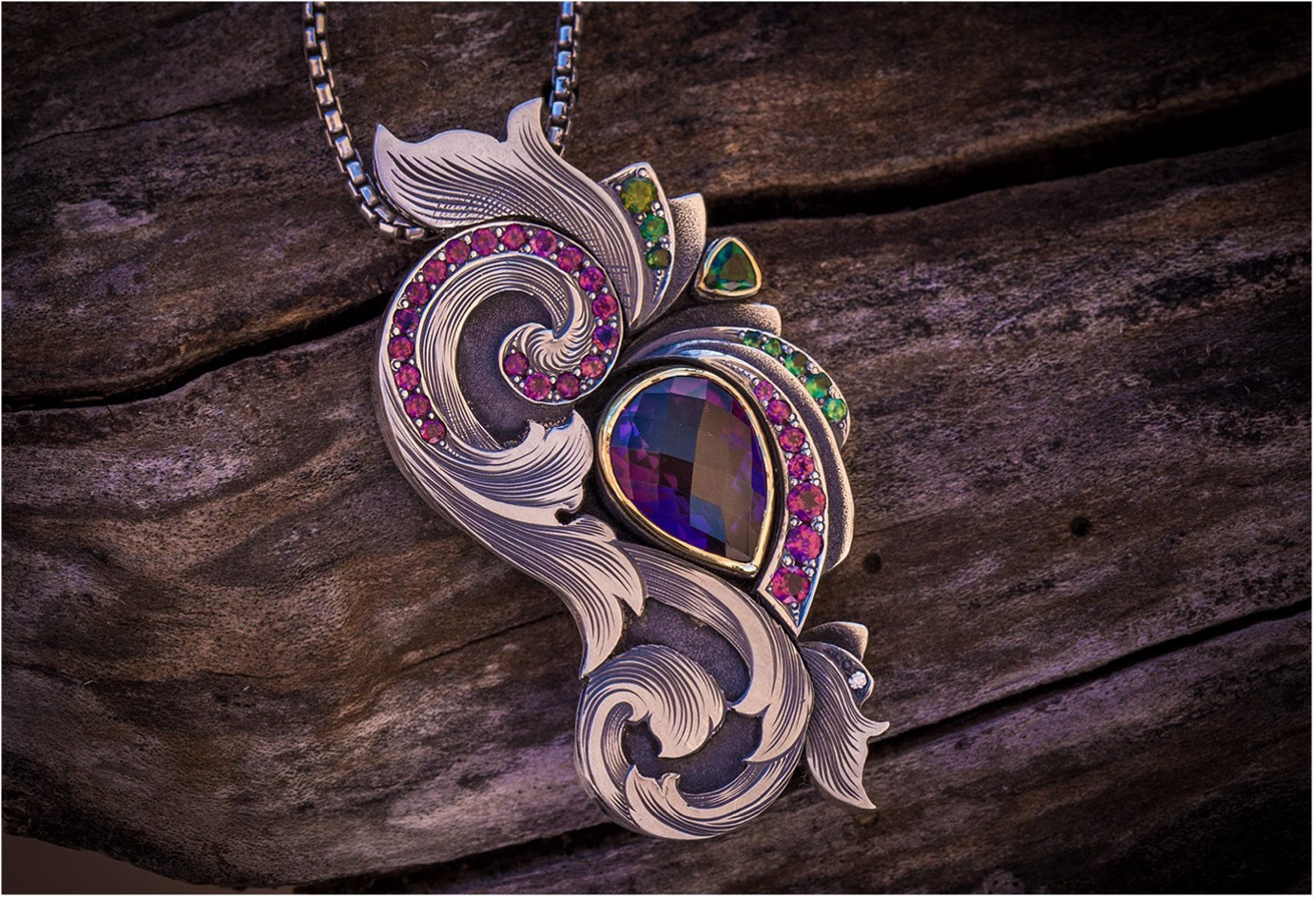
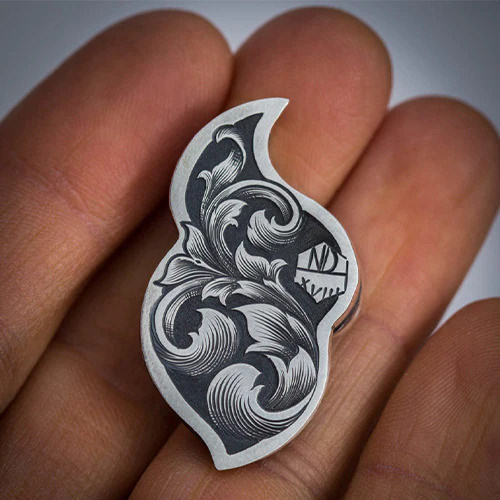
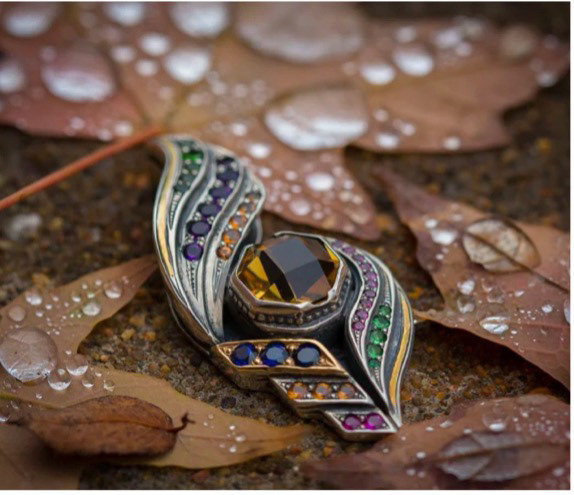
Nick Noyes is an American jewellery designer. His work includes both engraving and stone setting to create wearable pieces of artwork. He started making jewellery as a hobby only nine years ago and has since made a profession out if it, producing some incredibly increate hand engraved pendants, rings, and earrings. Nick has stated that he ‘loved creating and working with my hands. From the beginning, I fell in love with the alchemy of metalwork. I strive to make jewellery that catches the eye and brings you back for a second look’.
Nick has also specified that a main component of his practice is combining the ‘mediums of hand engraving and metallurgy’, something I hope to incorporate into my practice.
When Noyes first started crafting jewellery, he was inspired by putting his own gemstone collection to use, as well as finding something to do with his time, which quickly became his full-time job. Antique engraving books inspired him and was instantly captivated by the detail and rich history the craft had to offer. He now seeks inspiration from the world around him, whether that be nature, architecture, or even textiles.
I want to incorporate engraving in my practice, and specifically in this project, being inspired by traditional bobbin lace. Looking at Nick’s work has inspired me to look at potentially incorporating various stone settings, or even making a ‘stone’ out of engraved enamelled pieces.
Nick Noyes showing the process of making a piece
Sources:
- https://noyesdesigns.com/
Giò Pomodoro - Jewellery Artist
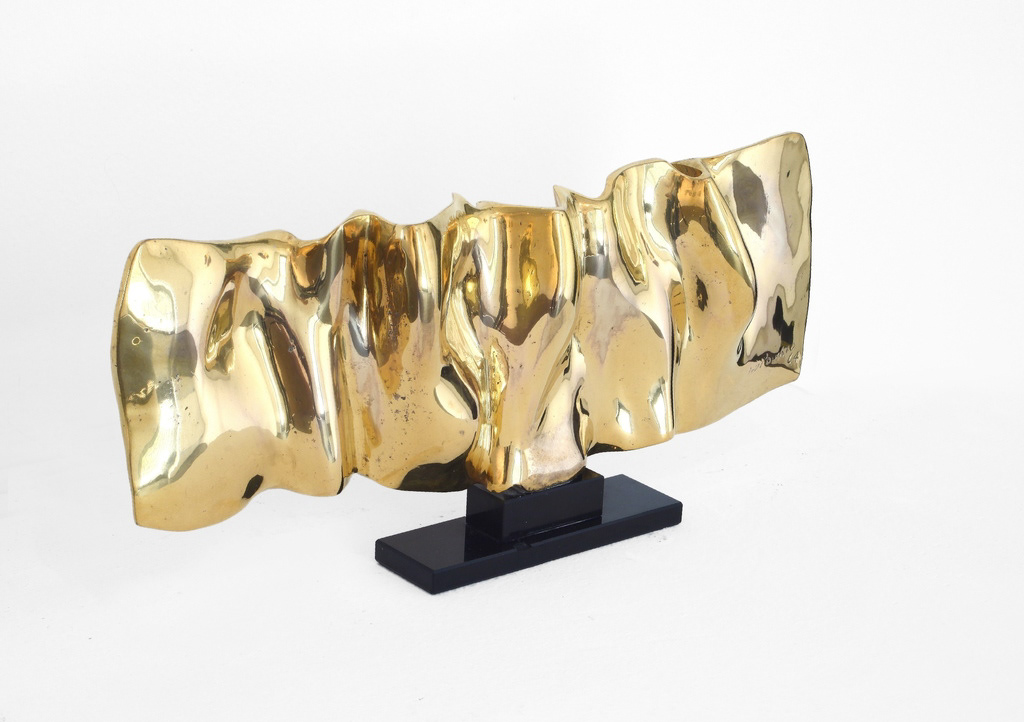
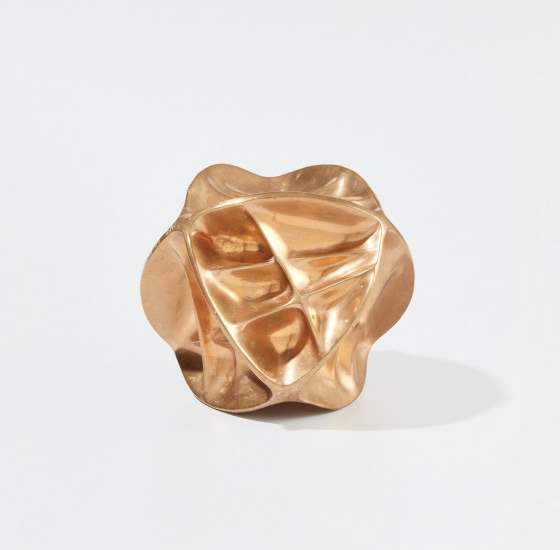
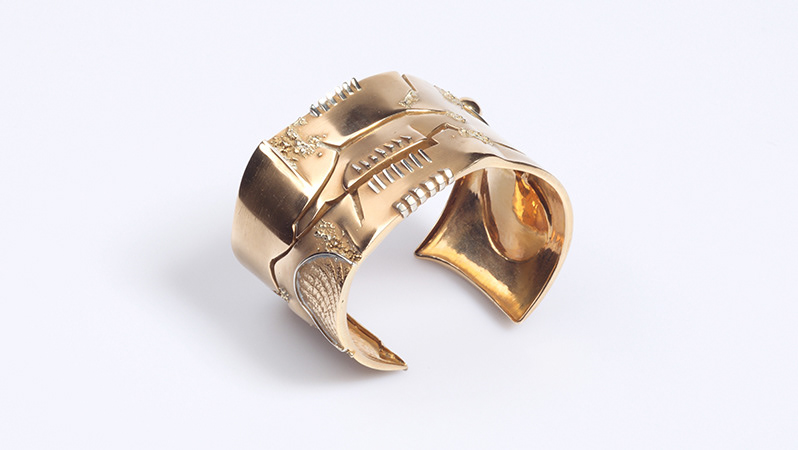
Giò Pomodoro was an Italian printmaker, sculptor and stage designer. In 1954 he moved to Milan, where he began his career in jewellery making. This work included producing reverse reliefs in clay and then began forming ensembles of various materials. This would often include, textiles, wood and then plaster which he would eventually cast in metal. Throughout the 1960s his work transformed into the form of sculpture, often on a larger scale, which was a drastic change from the jewellery he had been making.
One piece that Giò Pomodoro created was a modular ring. This piece contained a base ring made of 18k white gold which contained four interchangeable pieces. Each piece is made from 18k yellow gold and has been embellished with hand-painted enamel. The idea is you can switch out which piece is connected to the base ring and change what the ring looks like from day to day. Each piece is connected to the ring through a series of mechanical elements, combining the bold blocks of red, black, and white enamels.

The white square could be removed and screwed back into place to replace the piece being used

The back of the pieces, showing no counter enamelling was used
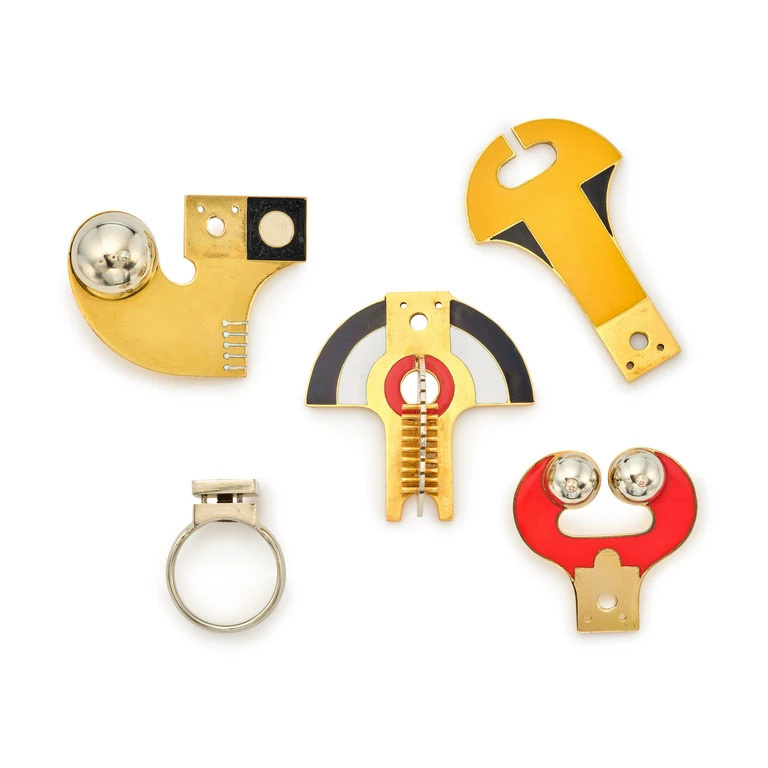
Enamelled interchangeable pieces
Sources:
Gio Pomodoro (2019) Available at: https://liveart.io/analytics/artworks/MYze3N/gio-pomodoro/a-unique-modular-ring-set (Accessed 23 October 2023)
Gio Pomodoro (2023) Available at: https://www.tate.org.uk/art/artists/gio-pomodoro-1786 (Accessed 23 October 2023)
Noyes Designs (2023) Available at: https://noyesdesigns.com/pages/about (Accessed: 23 October 2023)
Wendy Ramshaw - Jewellery Artist
Wendy Ramshaw was a British jeweller, ceramicist, and sculptor. Born in Sunderland in 1938, she later attended Newcastle College of Art studying fabric design. Later on in life, specifically in 1969, she went on to study at the Central School of Art and Design.
Ramshaw was first noticed when Mary Quant was selling her paper jewellery. This paper jewellery was interactive with the customers, where they would cut out the jewellery and assemble it from patterns.
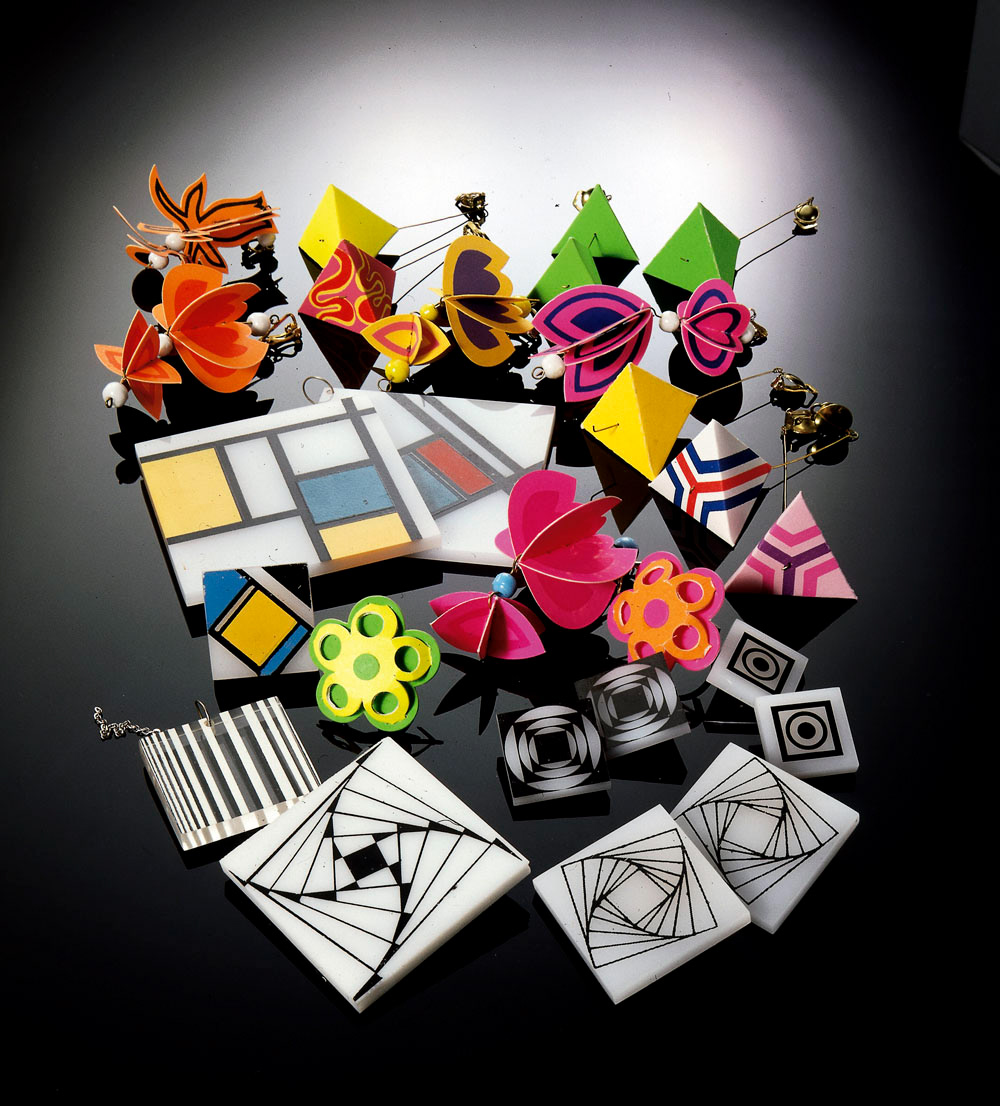
Paper jewellery

Modular Ring
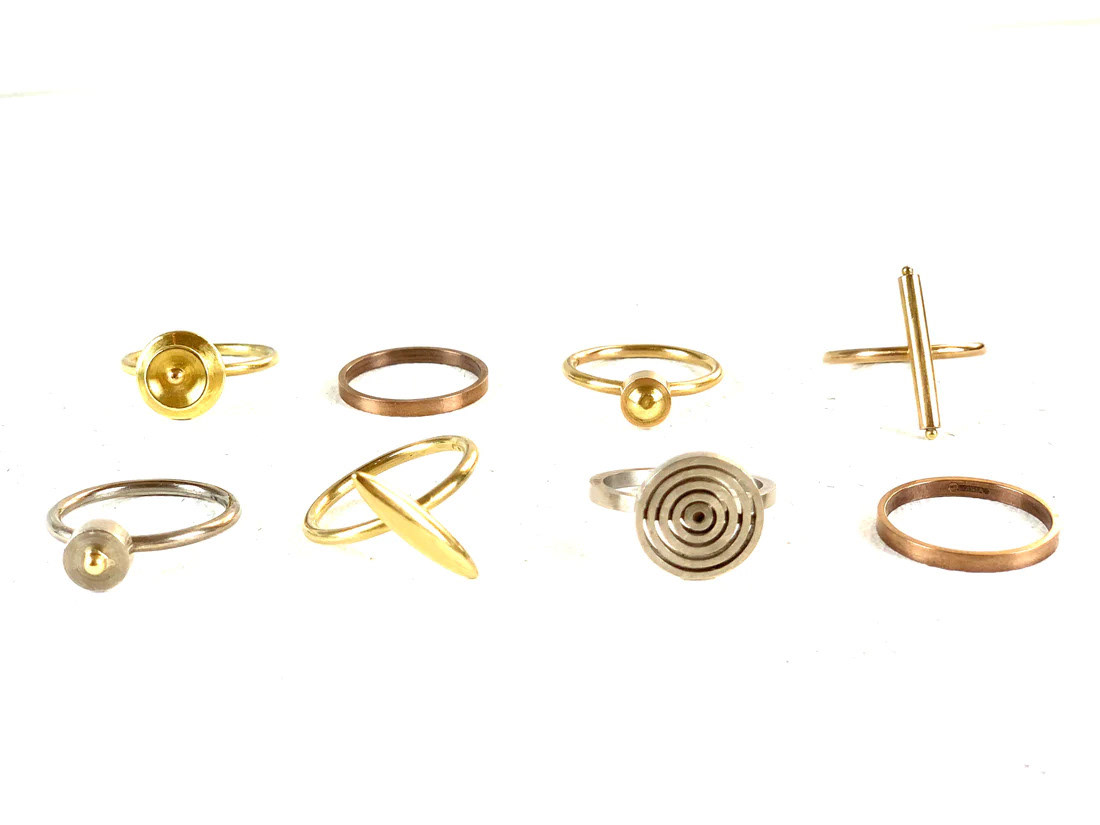
Modular Ring - Deconstructed
What drew me to Ramshaw’s work was her collection of rings. These rings often involved 5-7 separate rings that could be stacked and rearranged to the wearer's liking. This version of modular jewellery interests me and has made me think of the different capabilities of modular jewellery. I enjoy making rings and am fascinated by the idea of challenging different combinations and possibilities of rings, and how this interaction with jewellery could be relevant to different pieces, for example, necklaces. I plan to create a series of sketches that demonstrate different ways or mechanisms that I could use to make modular jewellery.
Sources:
- https://www.thejewelleryeditor.com/jewellery/interview/great-british-jewellery-designers-wendy-ramshaw-unique-jewellery-stacking-rings/
- https://www.britishmuseum.org/collection/term/BIOG77156
Sketchbook
Session Notes
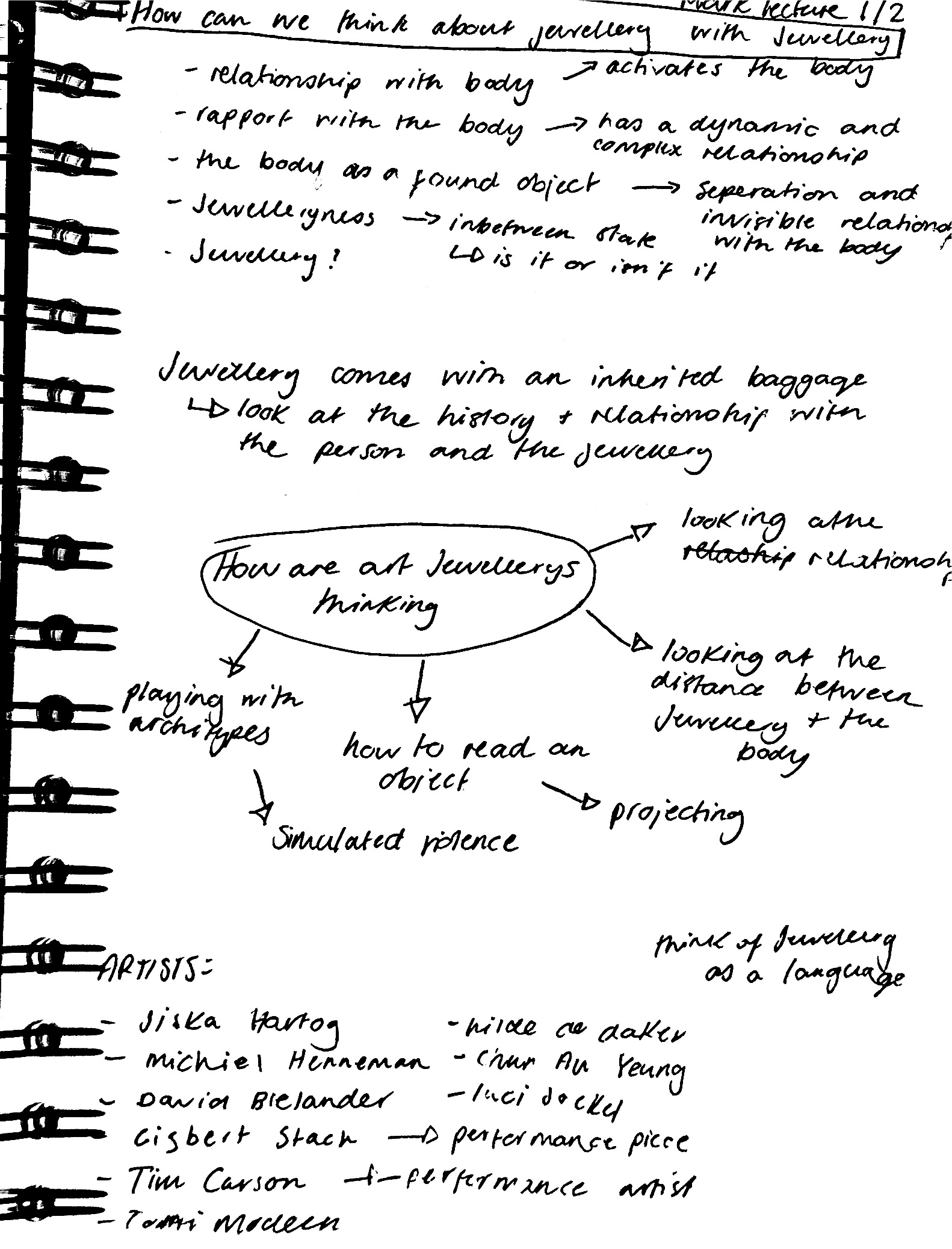
Mark jewellery session notes
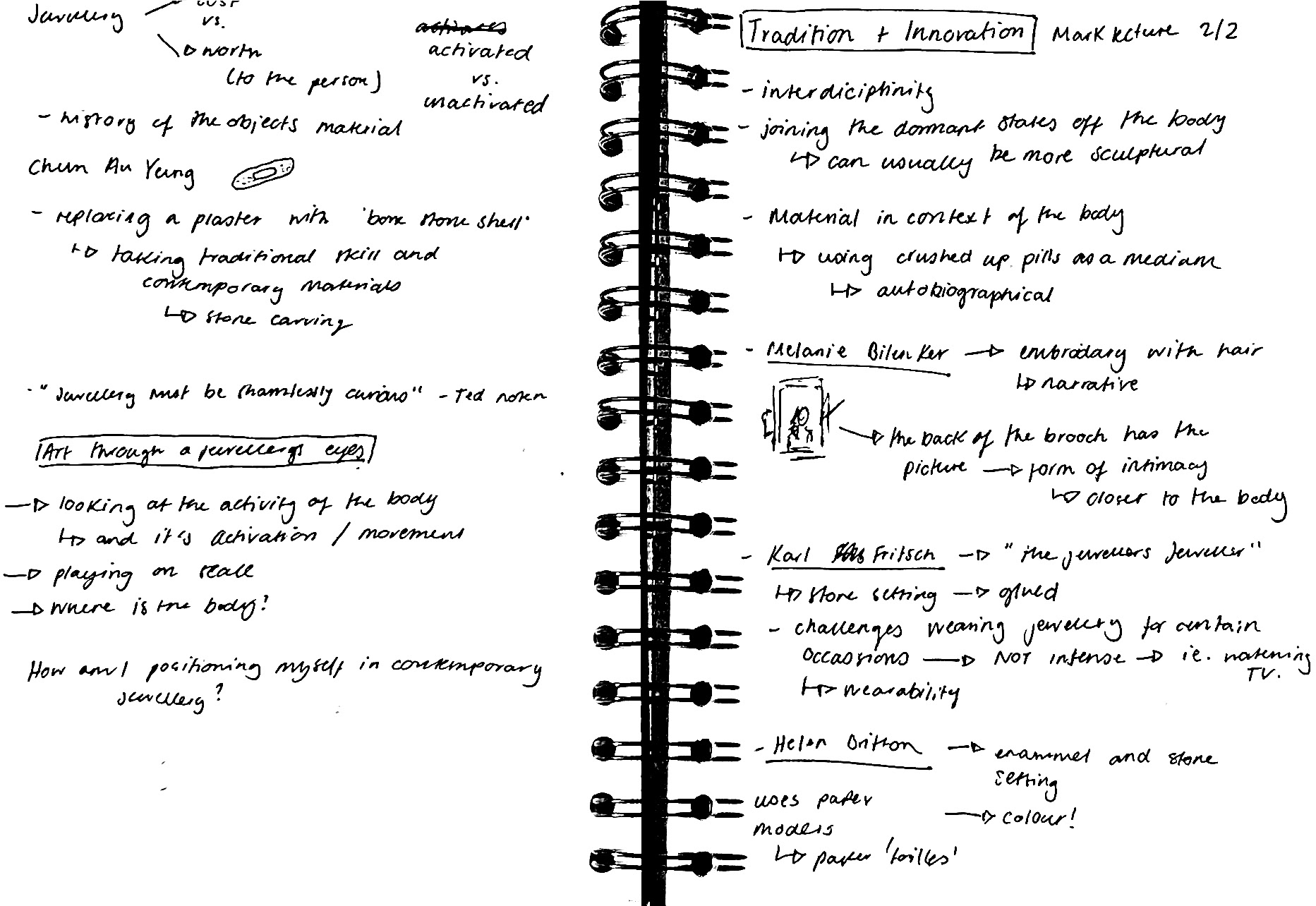
Mark jewellery session notes
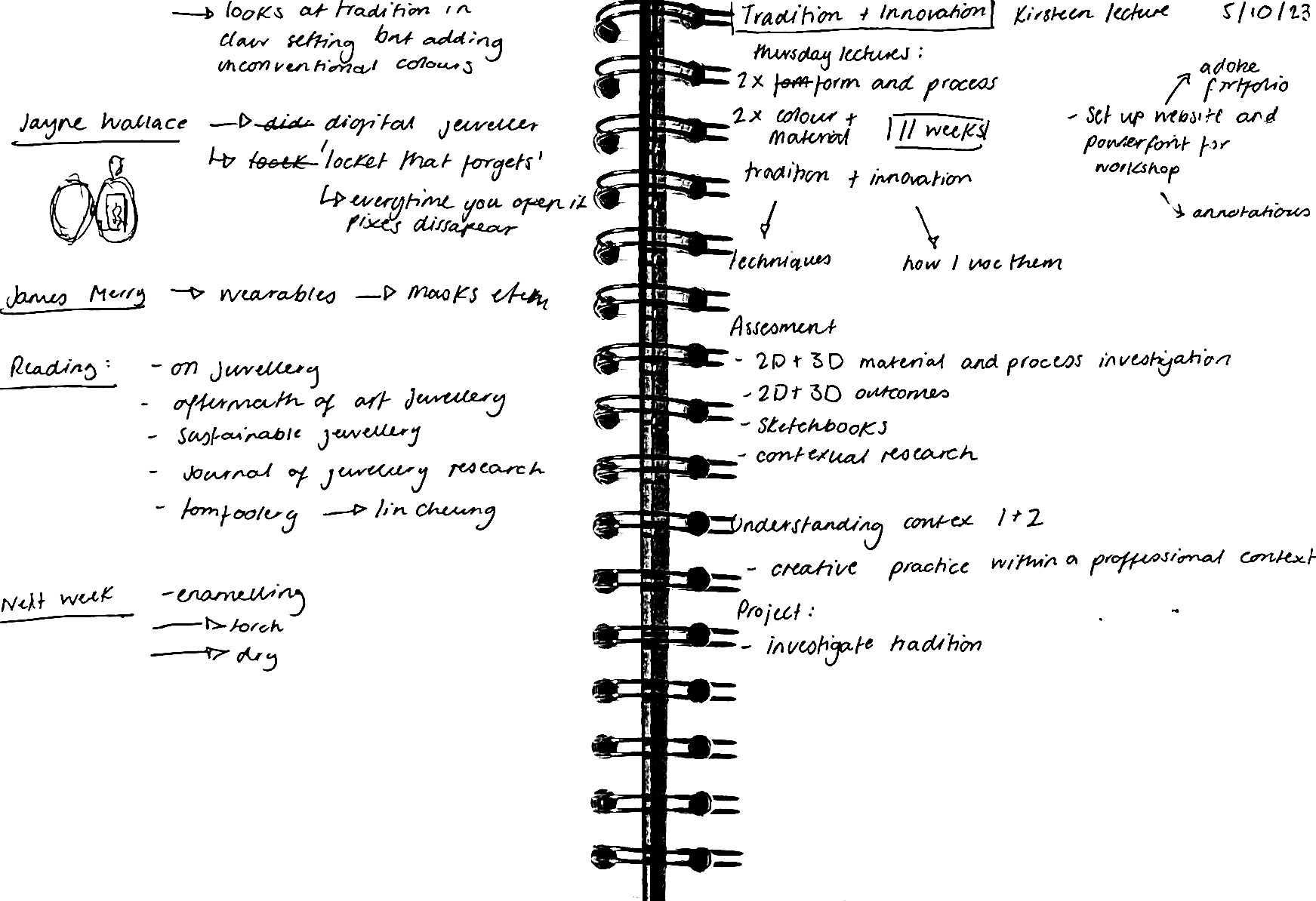
Mark jewellery session notes + Tradition and Innovation brief

Tradition and Innovation brief
Initial Ideas
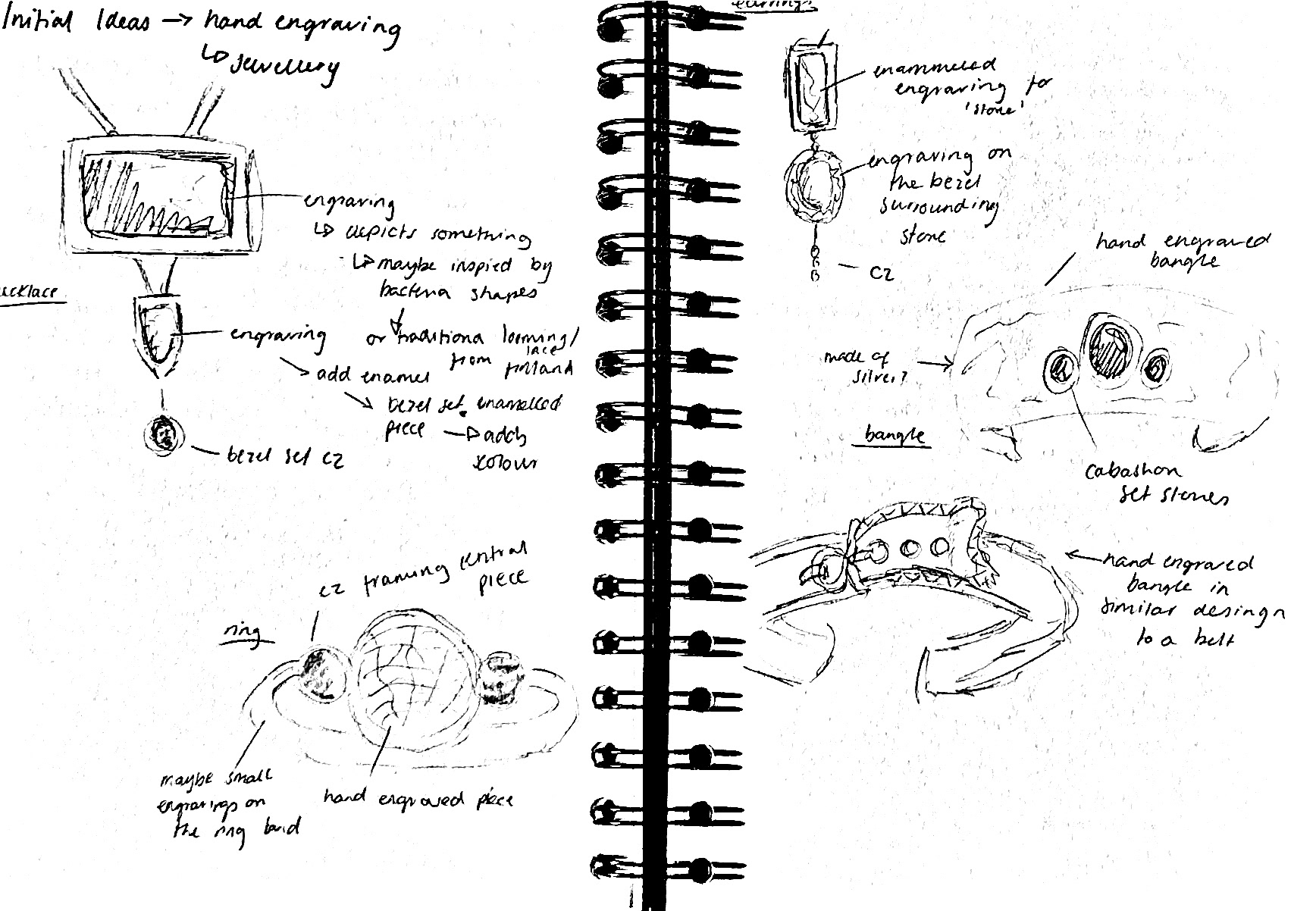
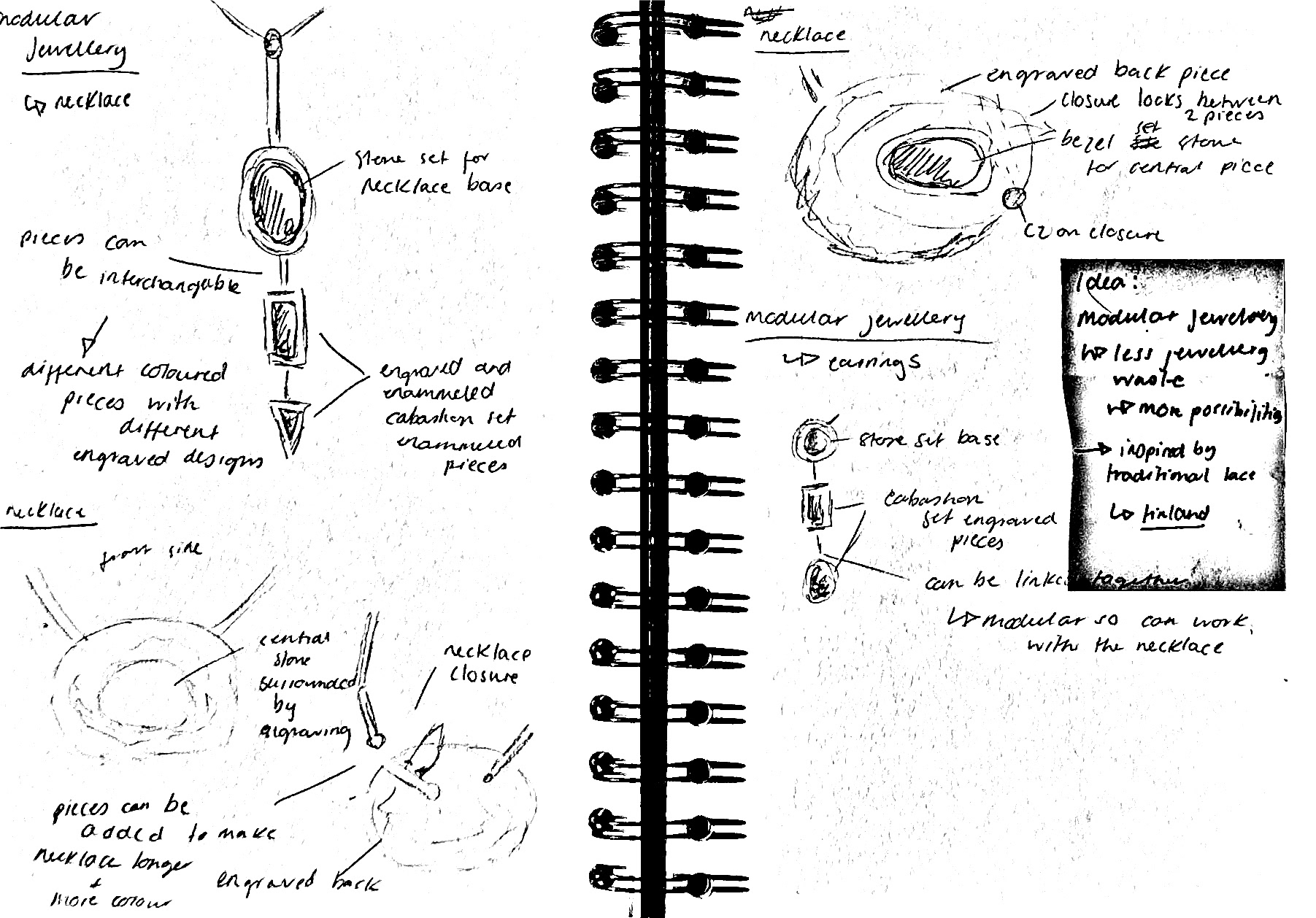
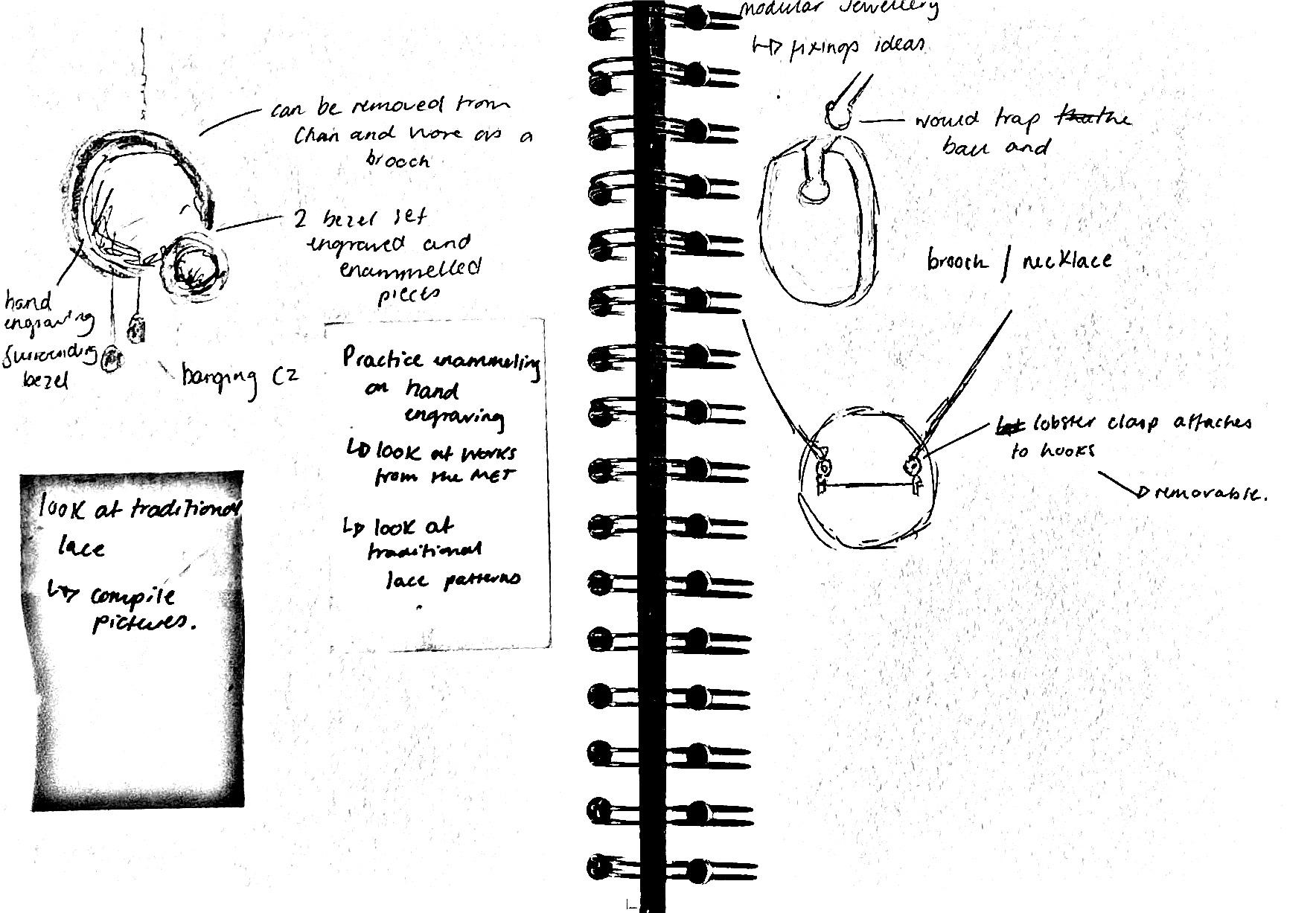
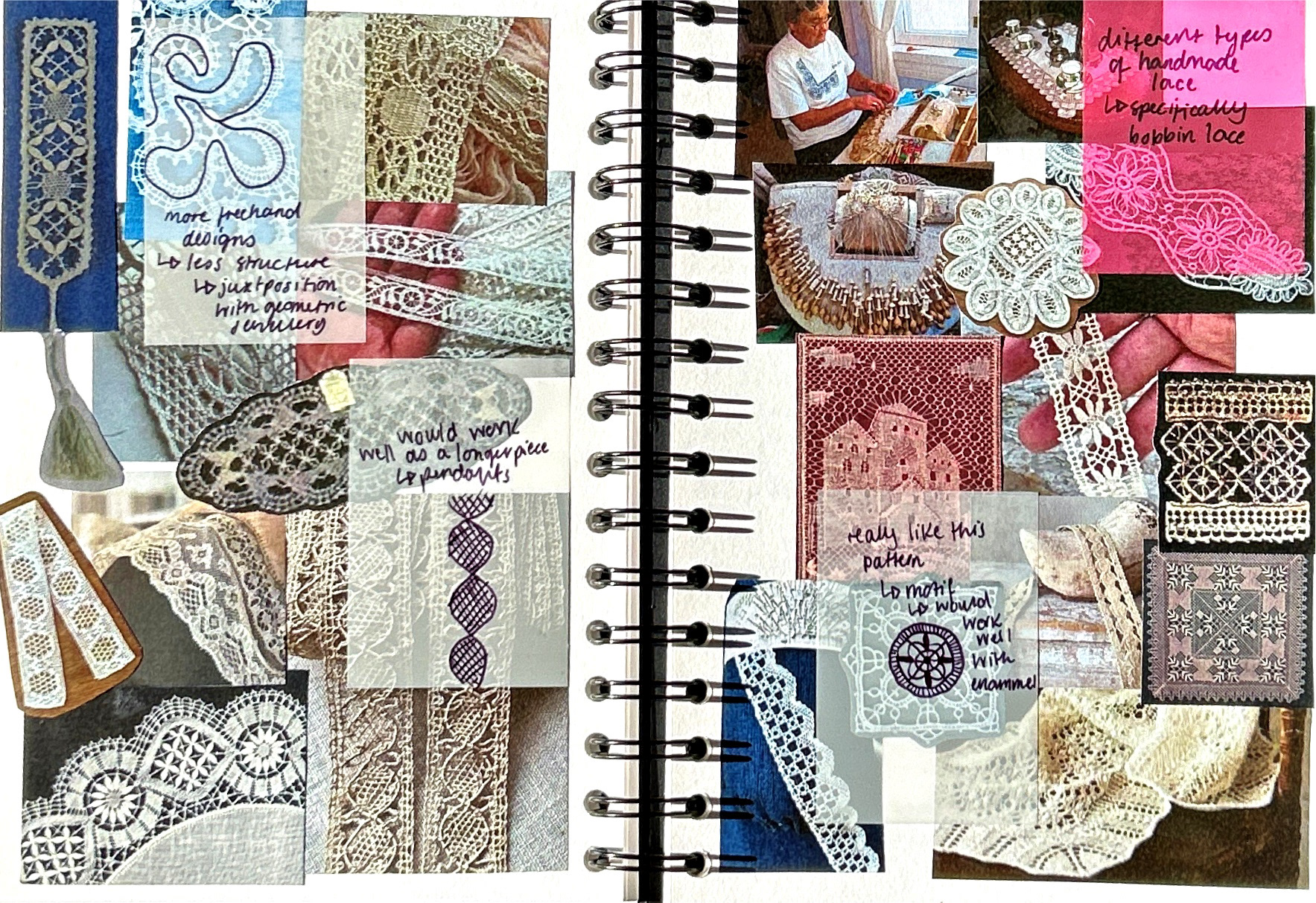
Started looking at bobbin lace for inspiration, as well as my own lace

Lino print inspired by lace
Enammeling Reading
While I knew I wanted to incorporate enamelling into my work, I started researching online into what this could look like. I read into the capabilities of both enamelling with engraving and the technique Basse-Taille. This technique involved engraving and then enamelling onto the surface. This results in a clear design where the glass has seeped into the shapes created by the engravers.


The Art of Fine Enamelling by Margerete Seeler, page 36
As well as that, I looked into the capabilities of stone setting combined with enamelling. These are both techniques I want to enhance, as I plan to use them throughout my practice.
This extract is from the book 'The Art of Fine Enamelling' by Margarete Seeler. The page explains stone settings on enamelled pieces. While I have never tried stone setting on top of enamel, this book has made me want to experiment and make samples with it, just to see whether I want to use it within my practice. It could add more depth to my pieces, but could potentially take away from the engraving I plan to use.
Artist Research - Felicity Peters
Craft Arts Internation, Issue 93, Page 100-111
Felicity Peters is an award-winning Australian jeweller based in Perth. Felicity's work is a collection of responses to the world she lives in, explaining that 'the landscape, political situations, personal philosophies, architecture, unusual objects and travel through the jewellery world is always challenging. The process stretches my intuition, knowledge and skills'. The materials she typically uses are precious stones, 18ct or 24ct gold, and sterling silver. Felicity also has an interest in deconstructing forms and reconstructing them in different combinations and eventually, into jewellery. This forces her to be creative and test her skill set while her ideas develop through making.
I admire her use of colour and intricate stone-setting techniques. These are both techniques I want to expand in my practice. I'm particularly interested in the stone-setting side of her practice, especially with the inventive claw settings. These are typically much larger, longer claw settings which I find fascinating. This leaves the stone exposed and vulnerable, even though it is securely set. This vulnerability of her jewellery is something you don't often see with precious stones.

Tourmalines, 18ct gold and diamonds
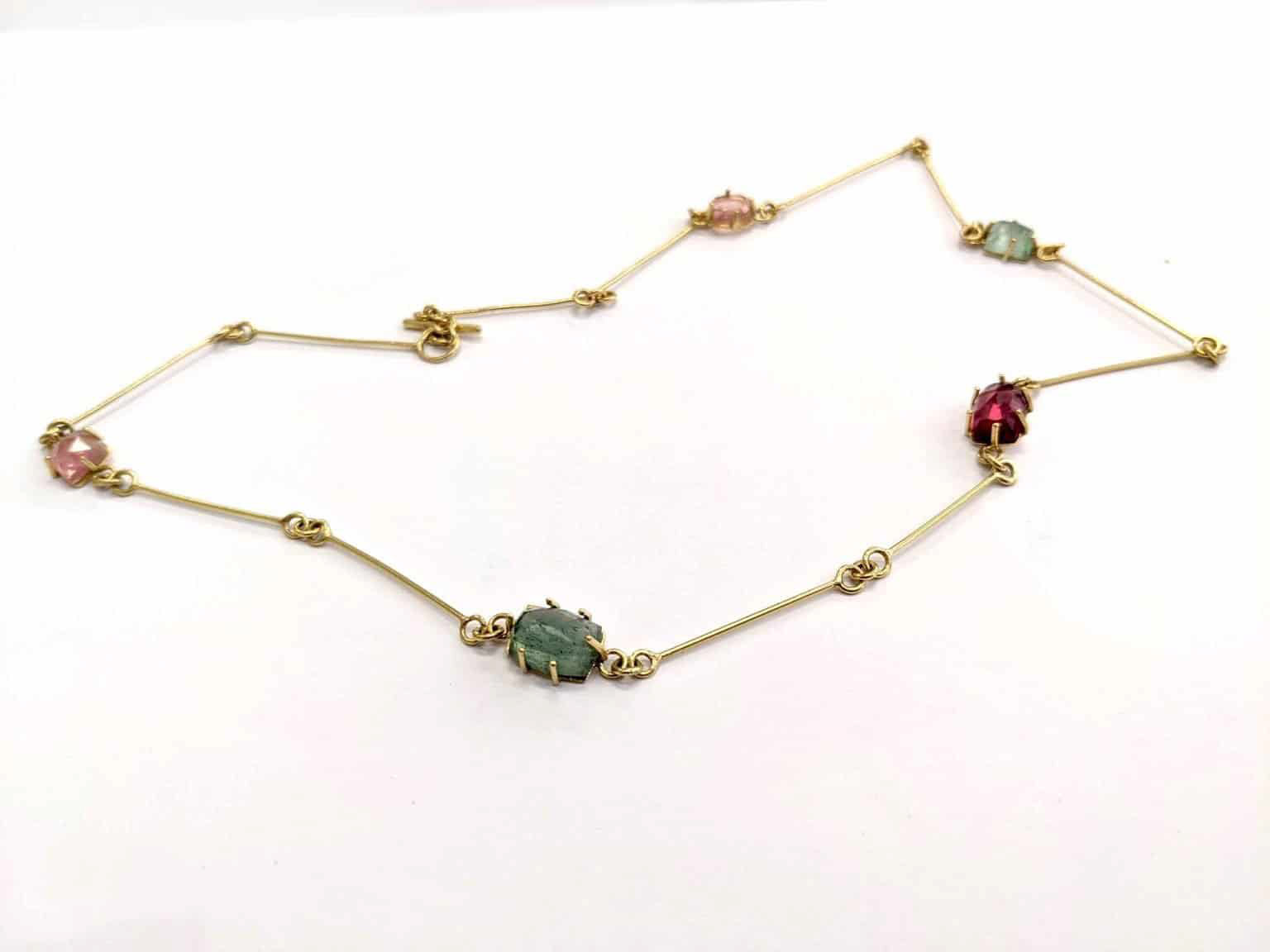
18ct gold and rose cut tourmaline necklace

Sterling silver, 24ct Gold, enamel, mixed media
With the necklace above, I really like how to connection between the stones and the bar looks. I'm going to experiment with the closures I can use on my jewellery, however, if I cannot find one that I am happy with, and functions the way I want it to, I will look more into using inventive stone settings and unique connections between my pieces. This will hopefully create a more modern look in my jewellery overall, which would be my innovation.
Sources:
- https://www.felicitypeters.com/01-about.html
Crit feedback
On week 5 of the project, we had a crit. This was a great opportunity to get feedback from tutors, as well as from my peers. After a short 2-minute presentation about my project, this was my feedback.
My feedback showed that my peers liked the fact that I had a personal connection with the lace used in my project, as well as how my research was developing.
Some advice and suggestions included pushing ideas of experimental stone-setting, as well as developing my connection with the lace. I don't want to roll the lace onto the metal for a couple of reasons, these being the potential damage the rolling mills could cause to the lace, and I don't want my project to lose the aspect of hand engraving. I plan to look into digitally scanning my work and experimenting with etching onto steel plates, which can then be used with the rolling mills. This could then be paired with hand engraving, either with the stone setting or on the design itself. Another idea would to just have a combination of the two techniques, I could have some examples of the rolling of the lace, and then some which are hand engraved pieces.
I was also advised to research the Mary Greg Collection, who collected everyday objects and was interested in preserving pre-industrial, handmade objects.
The Mary Greg Collection
The Mary Greg Collection is a collection currently held at Manchester Art Gallery. The collection consists of everyday objects collected between the late 1800s and early 1900s. These objects have been specifically picked for this collection because they have all been hand-crafted in one way or another. Mary Greg's objective when collecting these items was to preserve the handcrafted, pre-industrialised objects used in the everyday or 'examples of traditional artisan skills'.
While researching this collection I discovered that a significant number of the objects in the collection had not been preserved by Mary Greg before it was donated to the Manchester Art Gallery. I found this extract on the website from Sharon Blakey, who was a senior lecturer on 3D Design at MMU. Here it mentions how the collection of spoons was not 'prized or polished' and 'tarnished, worn, and broken'. I find this incredibly interesting as it shows that these objects were used, rather than just 'wasting away' in a collection somewhere. It also describes how these objects have been used so many times that the metal had begun to wear away on one side. This to me shows that these objects are made to last, compared to many industrialised and mass-produced objects. The objects breaking down and still being functional shows that they are built to last the tests of time. While I find this interesting I still don't want to use the lace in the rolling mills as it could potentially destroy memories for me, which I don't want to do, even if it meant having the lace imprinted in a more permanent form. I will look into other ways of having a more accurate representation of the lace in my designs.
What I will take from this collection is the art of preserving the handcrafts. While handmade lace is still made today, it is rather rare to see people wearing it. The delicacy of the lace makes it hard for people to wear as it can snag. I'm hoping that by preserving it in some way in jewellery, more people can know about this craft and by incorporating it into a wearable, it will make it easier to wear every day.
Sources:
- http://www.marymaryquitecontrary.org.uk/mary-greg
Photoshoot Inspiration
After completing my final piece, I plan on creating a series of photos showcasing my design. Below is the inspiration for this.

